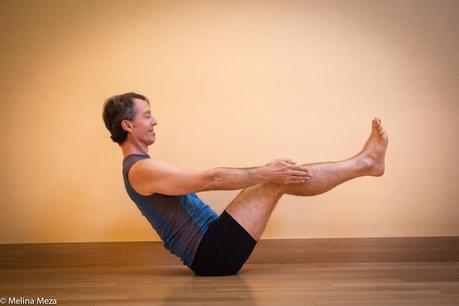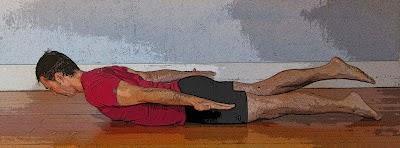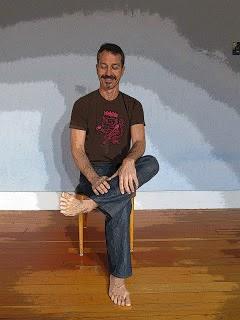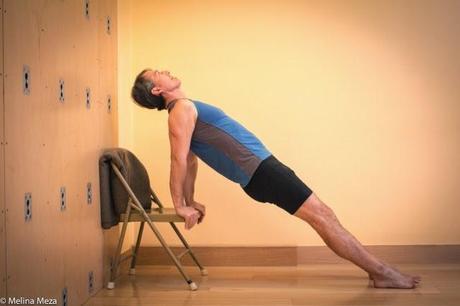 Deciding to undergo a total knee replacement (TKR) surgery is not an easy decision to reach. There are many factors that lead us to undergo this elective surgery. Most often it is because our quality of life is poor and we become frustrated with what we are unable to do. Also, having chronic pain can be very wearing and there comes a point when we really can’t tolerate it anymore.
Deciding to undergo a total knee replacement (TKR) surgery is not an easy decision to reach. There are many factors that lead us to undergo this elective surgery. Most often it is because our quality of life is poor and we become frustrated with what we are unable to do. Also, having chronic pain can be very wearing and there comes a point when we really can’t tolerate it anymore. It is at that point that we agree to have this surgery (see Knee Replacements and Yoga). Because many of us are pro-active in our health care and expect to be equal partners with our health care providers, we’ve been asked to write about how best to prepare for this surgery.
In general, when you consider practicing yoga for a specific condition or goal (which is when it crosses over into yoga therapy), for best results you should be global in your approach. Just muscle strengthening for a particular joint (knee) is not enough, as I will discuss below. So I’m going to break down pre-operative preparation into three basic categories.
Preparing for Emotional Health
The first area to consider is your emotional health and wellbeing. Setting your intentions is very important. Being able to do visualization, meditation, and basic breathing (pranayama) for stress management is critical pre-operatively. Practicing these skills so they become habitual will set the scene for a successful surgery and post-operative recovery. See The Relaxation Response and Yoga for information about using yoga to manage your stress.
You can also prepare spiritually for your upcoming surgery. Start by honestly confronting your own fears and emotional responses to having the surgery. Imagine what life will be like post operatively. The essence of yoga is cultivating equanimity in the face of difficulty. You might not always like what you have to accept but to surrender to it fully is how you can come to grips with difficult decisions.
So commit to your decision to undergo Knee Replacement Surgery as you would to any other form of work or practice (see Tapas: Working with Dedication). Choosing this surgery and doing the work to accept and fully believe in the success of the surgery sets your neural immunological system for success in a good surgical outcome. Your brain, emotions and belief systems are all part of your inherent healing mechanisms.
To address your psycho-emotional health pre-operatively, you can also examine your current sleep habits. Healthy sleep is imperative both pre-operatively to prepare us for the surgery as well as in the post-operative period.
Whether you employ principles of deep physical relaxation, practice good sleep hygiene habits, or both depends on you. See 5 Tips for Better Sleep for information.
Preparing Your Energetic Body
To prepare your energetic body for surgery, look at your breathing patterns and postural habits. When observing your breathing patterns, notice how you breathe and what you do with your breath when you are fearful or anxious versus when you are safe and relaxed. Observe what happens to your breathing pattern and overall postural holding when you imagine the surgery and the necessary care and work that will follow the surgery. Knowing your typical breathing patterns will allow you to cultivate breathing patterns to promote your sense of safety and relaxation.
To cultivate breathing patterns that promote safety and relaxation, I recommend taking a simple, comfortable position like Savasana and practicing simple Ujaii breathing with no retention or manipulation of the breath pattern.
Learning to identify your physical holding patterns can also aid your physical comfort both pre- and post-operatively. Pain is a stressor and affects you physically, so it is important to practice breathing to relax both your physical body as well as your mind.
Preparing Your Physical Body
Preparing physically for the operation is not just about strengthening your knee muscles; you should give attention to several physical areas, including your core, your hips, your legs, your ankles, and your upper body. And, obviously the way you can do asana will vary from person to person, as some of you can still get down to the floor while others cannot. But if you want to practice supine or seated poses and can’t get down to the floor, trying practicing on a tabletop. (Scoot your butt onto the table and then swing your legs up and onto the tabletop.)
The key to your preoperative management from a yogic therapy perspective is to consider your entire body. You may be having the surgery on “just your knee” but the effects of the procedure are global in how you will recover and heal.
Core. For basic core strength, practice Boat pose (Navasana) and variations.
 You can do leg lifts in Construction Rest position (on your back with knees bent and soles of the feet on the floor) or Bridge pose. March by lifting foot leg off of the ground and holding it up for a count of 5, and then repeat on the other side. Continue to alternate until your hips are fatigued.
You can do leg lifts in Construction Rest position (on your back with knees bent and soles of the feet on the floor) or Bridge pose. March by lifting foot leg off of the ground and holding it up for a count of 5, and then repeat on the other side. Continue to alternate until your hips are fatigued. Hips. To strengthen your hip abductors, price side-lying leg lifts (sometimes known as “clamshell”). If you can lie on your belly, practice left lifts in Locust pose (Salabasana).
 Also, lie on your back with pillows under your knees to support them in a bent-knee position, and then, one leg at a time, lift from your heel to straighten your knee.
Also, lie on your back with pillows under your knees to support them in a bent-knee position, and then, one leg at a time, lift from your heel to straighten your knee. Knees. For your problem knee, you can work on cultivating range of motion. You will either be having difficulty bending your knee (flexion) or straightening it (extension).
If you have problems bending your knee, try sitting on the edge of a chair with your leg stretched out in front of you. Then slowly step your foot backward the chair, gradually bending your knee, as far as you can. You can also try working with Dancer’s pose (Natarajasana), balancing on your good leg and slowly lifting your problem leg behind you in a bent knee position.
If you have problems straightening your knee, you can work with your leg in Krounchasana (Heron pose), either on the floor or seated on a chair, slowly straightening your upright leg as much as possible. Or, you can sit on one chair with another chair directly in front of you. Bring your problem leg onto the second chair seat so it is fully supported (your foot can be hanging off the edge), and slowly straighten your leg as much as possible, coming into a slight forward bend if desired.
Ankles. Simple ankle circles are excellent for circulation.
 For ankle flexibility, try sitting on the edge of a chair legs stretched out in front of you and, keeping the soles of your feet on the floor, walk your feet slowly back toward the chair until you feel a stretch on your calves and heel cords.
For ankle flexibility, try sitting on the edge of a chair legs stretched out in front of you and, keeping the soles of your feet on the floor, walk your feet slowly back toward the chair until you feel a stretch on your calves and heel cords. To strengthen the calves, practice rising onto your toes in Mountain pose. Start in Mountain pose with your soles of the feet completely on the ground and on an inhalation, rise up onto the balls of your feet. Exhale, and return to Mountain pose and repeat the cycle several times. This will also help cultivate your ability to balance. If it’s not possible to do this standing, you can make the same movements while sitting on the edge of your chair, with your feet on the floor in front of you.
Balance. Although balance is important to continue to cultivate, standing on your pre-operative leg in traditional yoga balance poses may not be possible due to pain and instability. So try this two-legged balance pose, which is a version of Mountain pose. Start in classic Mountain pose, with your feet parallel to each other. Then step your right heel in front of your left toes, so your two feet are in line with each other. To come out of the pose, step your right foot back to a parallel position with your left, and then repeat on the other side by stepping your left heel in front of your right toes.
You can also work with other aspects of balance and proprioception. Try Mountain pose with your eyes closed, for example. You might not realize how much you use your sight to balance, and removing sight from the equation helps foster other balancing abilities. Add in arm and/or head motions to challenge your balance even further.
Upper Body Strength. Because your arms will typically have to bear more weight after your knee replacement (because you can’t fully bear weight on the leg with the new knee replacement), working on upper body strength in advance will help you be more mobile after the operation.
To build upper body strength, try the chair version of Upward Plank pose. This helps build the muscles you’ll need for walking with crutches or a walker post-operatively.
 You can also work with either full Plank pose or the version on the forearms, which build both upper body and core strength.
You can also work with either full Plank pose or the version on the forearms, which build both upper body and core strength.  Standing Poses. Depending on your pain levels, full weight bearing may be limited for you and not causing pain or further joint deterioration is important. So learning to be flexible in how you do your standing poses is key. Rather than giving up these poses temporarily, you can continue to practice your standing poses with the aid of a chair. For example, you can do Warrior 2 pose with your pelvis on a chair seat, the bent front leg to one side of the chair and the straight leg stretched behind you on the other side. Other standing poses, including Warrior 1, Extended Side Angle, and Triangle pose, can be done in the same manner.
Standing Poses. Depending on your pain levels, full weight bearing may be limited for you and not causing pain or further joint deterioration is important. So learning to be flexible in how you do your standing poses is key. Rather than giving up these poses temporarily, you can continue to practice your standing poses with the aid of a chair. For example, you can do Warrior 2 pose with your pelvis on a chair seat, the bent front leg to one side of the chair and the straight leg stretched behind you on the other side. Other standing poses, including Warrior 1, Extended Side Angle, and Triangle pose, can be done in the same manner. Inverted and Restorative Poses. Supported inverted poses like Legs Up the Wall (Viparita Karani) are great for reducing swelling in the legs both pre- and post-operatively, as well stress management. However, you may not be able to get down to the floor to set up for and practice this pose. In this case, the easiest way to do Legs Up the Wall pose is on your bed, with your legs supported either by the headboard or the wall. Figuring out how to do this pose pre-operatively is a good idea because it will really help with edema management post-operatively.
For Savasana and reclined restorative poses, again, even if you have trouble getting up and down from the floor, you need not give up these important poses. One option is to practice these poses on a tabletop. Another option is to practice the poses on a firm bed that is not the one you usually sleep in.
Subscribe to Yoga for Healthy Aging by Email ° Follow Yoga for Healthy Aging on Facebook ° Join this site with Google Friend Connect

